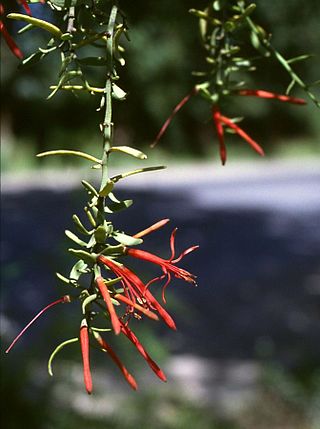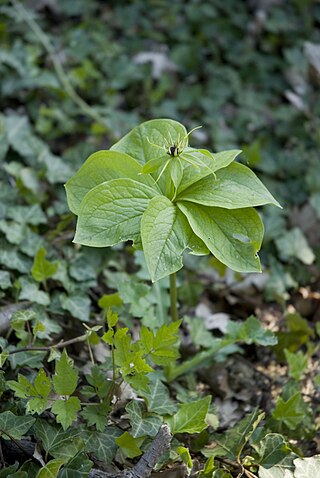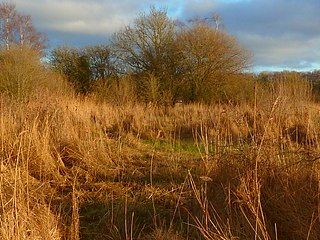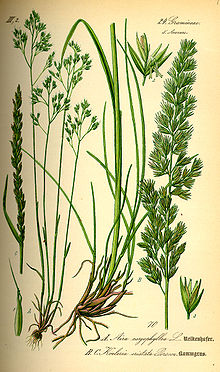
Royal Botanic Gardens, Kew is a non-departmental public body in the United Kingdom sponsored by the Department for Environment, Food and Rural Affairs. An internationally important botanical research and education institution, it employs 1,100 staff. Its board of trustees is chaired by Dame Amelia Fawcett.

Loranthaceae, commonly known as the showy mistletoes, is a family of flowering plants. It consists of about 75 genera and 1,000 species of woody plants, many of them hemiparasites. The three terrestrial species are Nuytsia floribunda, Atkinsonia ligustrina, and Gaiadendron punctatum Loranthaceae are primarily xylem parasites, but their haustoria may sometimes tap the phloem, while Tristerix aphyllus is almost holoparasitic. For a more complete description of the Australian Loranthaceae, see Flora of Australia online., for the Malesian Loranthaceae see Flora of Malesia.

Brooklyn Botanic Garden (BBG) is a botanical garden in the borough of Brooklyn, New York City. It was founded in 1910 using land from Mount Prospect Park in central Brooklyn, adjacent to Prospect Park and the Brooklyn Museum. The 52-acre (21 ha) garden holds over 14,000 taxa of plants and has nearly a million visitors each year. It includes a number of specialty "gardens within the Garden", plant collections, the Steinhardt Conservatory that houses the C. V. Starr Bonsai Museum, three climate-themed plant pavilions, a white cast-iron-and-glass aquatic plant house, and an art gallery.

Alfred Gabriel Nathorst was a Swedish Arctic explorer, geologist, and palaeobotanist.

Nathaniel Lord Britton was an American botanist and taxonomist who co-founded the New York Botanical Garden in the Bronx, New York.

Fallopia is a genus of about 12 species of flowering plants in the buckwheat family, often included in a wider treatment of the related genus Polygonum in the past, and previously including Reynoutria. The genus is native to temperate and subtropical regions of the Northern Hemisphere, but species have been introduced elsewhere. The genus includes species forming vines and shrubs.

Paris quadrifolia, the herb Paris or true lover's knot, is a species of flowering plant in the family Melanthiaceae. It occurs in temperate and cool areas throughout Eurasia, from Spain to Yakutia, and from Iceland to Mongolia. It prefers calcareous soils and lives in damp and shady places, especially old established woods and stream banks.

Gagea lutea, known as the yellow star-of-Bethlehem, is a Eurasian flowering plant species in the family Liliaceae. It is widespread in central Europe with scattered populations in Great Britain, Spain, and Norway to Siberia and Japan.

Molinia, or moor grass, is a genus of two species of flowering plants in the grass family, native to damp moorland in Eurasia and northern Africa. They are both herbaceous perennial grasses.

The sand leek, also known as rocambole and Korean pickled-peel garlic, is a Eurasian species of wild onion with a native range extending across much of Europe, Middle East, and Korea. The species should not be confused with rocambole garlic, which is A. sativum var. ophioscorodon.

Otto Stapf FRS was an Austrian born botanist and taxonomist, the son of Joseph Stapf, who worked in the Hallstatt salt-mines. He grew up in Hallstatt and later published about the archaeological plant remains from the Late Bronze- and Iron Age mines that had been uncovered by his father.

Pier Andrea Saccardo was an Italian botanist and mycologist. He was also the author of a color classification system that he called Chromotaxia. He was elected to the Linnean Society in 1916 as a foreign member. His multi-volume Sylloge Fungorum was one of the first attempts to produce a comprehensive treatise on the fungi which made use of the spore-bearing structures for classification.

Butomus is the only known genus in the plant family Butomaceae, native to Europe and Asia. It is considered invasive in some parts of the United States.
The Plant List was a list of botanical names of species of plants created by the Royal Botanic Gardens, Kew and the Missouri Botanical Garden and launched in 2010. It was intended to be a comprehensive record of all known names of plant species over time, and was produced in response to Target 1 of the 2002–2010 Global Strategy for Plant Conservation, to produce "An online flora of all known plants". It has not been updated since 2013, and has been superseded by World Flora Online.

Avenula is a genus of Eurasian flowering plants in the grass family. Over 100 names have been proposed for species, subspecies, varieties, and other infraspecific taxa within Avenula, but only one species is accepted. The others names are all regarded as synonyms of other accepted names. The only recognized species in the genus is Avenula pubescens, commonly known as downy oat-grass or downy alpine oatgrass, native to Europe and Asia from Iceland and Portugal to Xinjiang, Mongolia, and Siberia. It is also naturalized in scattered locations in North America, in states as Connecticut, Delaware, Minnesota, New Jersey and Vermont, and in Canadian provinces such as Alberta, Manitoba, Ontario, Quebec, and Saskatchewan.

Aven Nelson was an American botanist who specialized in plants of the Rocky Mountains. He was one of the founding professors of the University of Wyoming, where he taught for 55 years as professor and served as president (1918-1922). He served as president of the American Society of Plant Taxonomists and Botanical Society of America.

Hypericum virginicum, the marsh St. Johns-wort or Virginia marsh St. Johnswort, is a species of flowering plant in the family Hypericaceae. It is native to the central and eastern United States and eastern Canada.

Hypericum fasciculatum, known as peelbark St. Johnswort or sandweed, is a species of flowering plant in the St. Johnswort family, Hypericaceae, native to the southeastern United States. It is found from eastern North Carolina, south to southern Florida, west to eastern Louisiana. Kew's Plants of the World Online database also notes that it occurs in Cuba, though Cuba is not listed in several other sources. It was first described in 1797 by Jean-Baptiste Lamarck.

Hypericum lobocarpum, commonly called fivelobe St. Johnswort, is a species of flowering plant in the St. Johnswort family (Hypericaceae). It is native eastern to North America, where it is found primarily in the western portion of the southeastern United States. Its typical natural habitat is in open wet areas, such as stream banks, lake margins, swamps, and pine savannas.

Farnham Mires is a Site of Special Scientific Interest, or SSSI, to the east of the village of Farnham, North Yorkshire, England. It consists of a spring-fed marshy fen or mire with reeds and sedge, and drier calcareous grassland containing a diverse range of flora. It has a history of poaching and fox hunting, but since the late 19th century, the attention of botanists has been drawn to its large variety of flowering plants. It has received some consideration on this account since 1944, and from 1954 it was designated SSSI status. This site has no facilities, and is not open to the public.



















